Final report for ONC17-027
Project Information
Short growing seasons in the North Central Region limit farmers’ participation in local food markets. High tunnels are valuable tools for season extension. Farmers who consistently grow tomatoes in high tunnels need additional high-value crops to increase the sustainability of the production systems. As a potentially promising alternative, greenhouse cucumbers are high-value and high-demand crops, but low soil temperatures in early spring limit its extended season production in high tunnel systems. This project introduces grafting technology with cold tolerant rootstocks to address this challenge. Nine farmers in Indiana and one farmer in OH have collaborated in the project. Fifteen on-farm trials were conducted in 2017 and 2018 spring production season. Grafted cucumbers enhanced transplant survival rate, and in most cases, increased early-season cucumber yield. The most pronounced effects were observed when cucumbers were grown in heated high tunnels that the crop was planted as early as in February. The estimated cost of the grafted transplants was about 2.3 times more expensive than normal cucumber transplant, but partial return analysis indicated that farmers growing the grafted plants is economically feasible. Results of the project were distributed to farmers through presentations, demonstrations at grower meetings, field days and newsletter articles. An extension bulletin and a video were developed to teach the grafting technology. Immediate outcomes of the project are improved yield and extended harvest duration of cucumbers grown in high tunnel systems. In the long term, the changes in farmers’ activities increase the sustainability of high tunnel production system and increase farmer income.
Objective 1. Evaluate the effectiveness of using grafting technology to enhance early season
production, control pests and increase the yield of seedless cucumbers grown in high tunnel systems.
Objective 2. Determine the economic feasibility of integrating grafting technology into high tunnel greenhouse cucumber production systems.
Objective 3. Train farmers on cucumber grafting technique, and develop and deliver extension programs on the integrated use of grafting technology in growing greenhouse cucumbers in high tunnel systems in the North Central Region.
Cooperators
- (Researcher)
- (Researcher)
Research
Background information collection
We collected information from farmers regarding their preferred cucumber varieties and targeted transplanting date before the start of the production season. Most information was collected through personal visit, phone calls or email conversation. We talked to about 18 farmers who have grown cucumbers or plan to grow cucumbers in high tunnels. We also provided our recommendation regarding variety choice, cultural practices, and pest control approaches to farmers.
Producing grafted transplants
Cucumber transplants were produced at the Southwest Purdue Ag Center in Feb.-Mar. 2017 and 2018. Plants were grafted with one-cotyledon method. Briefly, the scion plant was cut at the hypocotyl and attached to the rootstock plant that has had one of the cotyledons and the apical meristem tissue removed. Grafted plants were healed in a healing chamber that was built on the greenhouse bench with polyvinyl chloride pipe frame and plastic film cover. During the first three days, temperatures inside the chamber were 28 ± 3 °C with relative humidity close to 100%. Relative humidity was gradually reduced after day 3 to around 60% after 6 d. Grafting survival rate was above 90%.
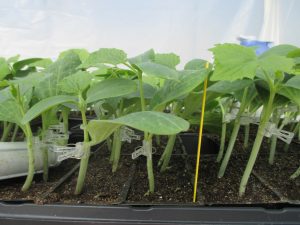
Crop production and data collection
Cucumbers were grown following production practice used by each of the collaborating farmers. We prepared a pest management recommendation sheet and handed to farmers. We also provided farmers data entering sheet that can be easily used to record data and make notes on observation. Data logos were installed on each site to automatically measure soil and air temperatures.
Table 1. Collaborate farms, and their production systems in 2017
|
Collaborate farms |
Production system |
Transplant date |
Plant number per treatment |
In-row spacing |
Trellis system |
Organic |
|
Freedom Valley Farm |
High tunnel |
Mar. 27, 2017 |
17 |
30 |
Single leader |
Yes, not certified |
|
White Violet Center |
High tunnel |
Mar. 31, 2017 |
15 |
18 |
Trellis netting |
Yes, certified |
|
Bud’s Farm Market |
High tunnel |
Mar. 31, 2017 |
5-23 depending on varieties |
18 |
Single leader |
Yes, not certified |
|
Bud’s Farm Market |
Open field |
Apr. 23, 2017 |
23 |
24 |
No trellis |
Yes, not certified |
|
Silverthorn Farm |
High tunnel |
Apr. 1, 2017 |
|
18 |
Single leader |
Yes, not certified |
Table 2. Cucumber varieties evaluated at each of the collaborate farms in 2017. The same number of grafted and non-grafted plants were grown at each site.
|
Collaborate farms |
Corinto |
Sweet Success |
Excelsior |
Socrates |
Taurus |
Diva |
|
Freedom Valley Farm |
Yes |
Yes |
|
|
|
|
|
White Violet Center |
|
Yes |
Yes |
Yes |
Yes |
|
|
Bud’s Farm Market |
|
Yes |
|
Yes |
Yes |
Yes |
|
Silverthorn Farm |
Yes |
|
|
|
|
|
Table 3. Collaborate farms, and their production systems in 2018
|
Collaborate farms or farmers name |
Production system |
Transplant date |
Plant number per treatment |
In-row spacing |
Trellis system |
Organic |
|
Bud’s Farm Market |
Heated hightunnel |
Feb. 27 |
Varied by variety |
1’ |
One-leader |
Organic not certified |
|
The Weathered Plow farm and greenhouse |
Heated hightunnel |
Feb. 27 |
30 |
1’ |
One-leader |
Conventional |
|
The Weathered Plow farm and greenhouse |
High tunnel |
Apr. 11 |
Varied by variety |
1’ |
One-leader |
Conventional |
|
S&E produce & flowers |
High tunnel |
Apr. 26 |
14 |
2’ |
One-leader |
Conventional |
|
Freedom Valley Farm |
High tunnel |
Mar. 30 |
Varied by variety |
1’ |
Netting |
Organic not certified |
|
Perkins’ good earth farm |
High tunnel |
Apr. 18 |
12 |
1’ |
One-leader |
Organic not certified |
|
White Violet Center |
High tunnel |
Apr. 23 |
15 |
1’ |
One-leader |
Certified organic |
|
John Raber |
Heated high tunnel |
Feb. 22 |
50 |
1.5’ |
One-leader |
Conventional |
|
Garcia's Garden |
High tunnel |
Apr. 10 |
20 |
1’ |
One-leader |
Organic not certified |
|
Steve Willi |
High tunnel |
|
20 |
|
One-leader |
Conventional |
Table 4. Cucumber varieties evaluated at each of the collaborate farms in 2018.
|
Collaborate farms |
Corinto |
Sweet Success |
Excelsior |
Iznik |
Socrates |
Taurus |
County Fair |
Diva |
|
Bud’s Farm Market |
Yes |
Yes |
|
|
Yes |
|
|
|
|
Becky Brubaker |
Yes |
|
|
|
Yes |
Yes |
|
|
|
Freedom Valley Farm |
Yes |
|
|
|
|
|
Yes |
|
|
Perkins’ good early farm |
|
|
|
Yes |
Yes |
|
|
|
|
White Violet Center |
Yes |
|
Yes |
|
|
Yes |
|
|
|
John Raber |
Yes |
|
|
|
Yes |
|
|
|
|
Garcia's Garden |
|
|
Yes |
|
|
|
|
Yes |
|
Steve Willi |
Yes |
|
|
|
Yes |
|
|
Yes |
What we found during background information collection
- Not all the farmers understand technical words commonly used to describe cucumber varieties.
- In terms of seedless cucumber varieties, Corinto is a popular slicing cucumber, but growers are also interested in other types of cucumbers, particularly long-type cucumbers.
- In USDA hardiness zone 5 and 6, cucumbers were planted in end March to early May in unheated high tunnels. If heating is available, growers would target transplant as early as end Feb.
2017 results
The difference in the transplant survival rate of grafted vs. non-grafted cucumber plants was observed in the open-field trial at the Bud’s farmers market. 52% of non-grafted Diva cucumber seedlings died 7 d after transplanting, while all the grafted Diva plants survived. Following transplanting, the lowest recorded air temperature on the site was 46 °F. Average air temperatures in the week following transplanting ranged from 52-73 °F. The observation indicated that grafted cucumbers are more likely to survive during suboptimal temperature conditions that often occur in the early spring.
Pronounced yield increase of grafted cucumbers was observed at White Violet Center. The highest yield increase was observed on Excelsior (159%). One of the reasons that lead to the dramatic yield difference was because of plant loss due to bacterial wilt. Almost all the non-grafted Excelsior plants were died becuase of bacterial wilt while more than half of grafted Excelsior plants were still producing in July (Fig. 1). Although the different response toward bacterial wilt of grafted vs. non-grafted cucumber plants was observed at the White Violet Center, no difference on plant survival under bacterial wilt pressure was observed at Freedom Valley Farm, at where, regardless of grafted or non-grafted plants, a tremendous amount of plants were lost due to bacterial wilt in June. Yield increase of other cucumber varieties ranged from 27% to 97% at the White Violet Center. Grafted plants had stronger stems compared to non-grafted cucumbers (Fig. 2) The farmer is very happy with the performance of grafted cucumbers.
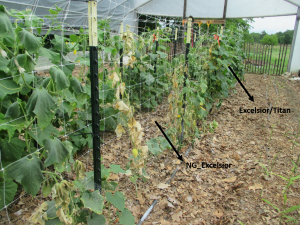
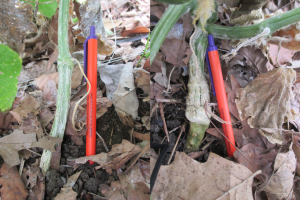
Grafted Corinto increased yield by 6% at Freedom Valley Farm. As Corinto and Sweet Success seem to be more cold tolerant compared to other greenhouse cucumbers. Response of the two varieties to grafting in terms of the improved cold tolerance may be decreased. However, according to growers’ observation, grafted plants were taller and more vigorous compared with the non-grafted plants.
Two trials were conducted at Bud’s Farmers Market, one in a high tunnel and another one in the open-field. More than half of transplant failure of non-grafted Diva lead to a significantly lower yield of non-grafted plants compared to grafted Diva. The farmer also indicated that he normally planted cucumbers every 4-6 weeks. But growing grafted plants allow him harvesting cucumbers from June to Sep. with one planting, which dramatically saved his labor to grow transplants and field planting.
Insects netting was installed in the high tunnel at Bud's Farmers Market that effectively controlled cucumber beetles. No bacterial wilt was observed. Unexpected, we saw a negative effect of grafting in this trial. Yields of grafted plants were lower than non-grafted plants with all the evaluated varieties. We suspect it is the poor quality of grafted plants that lead to the lower yields. It is possible that the grafted plants were not fully recovered before planted in the high tunnel at Bud’s Farmers Market. The trial will be repeated at the same site in 2018, which could provide us more opportunities to better understand why grafting did not work in this case.
Table 1: Cucumber yield at the Freedom Valley Farm (Harvest duration: May 5 --- June 17)
|
Treatment |
Lb |
Num |
Lb per plant |
Num per plant |
|
NG_Corinto |
89.52 |
152 |
5.26 |
8.94 |
|
Corinto/Titan |
94.84 |
164 |
5.57 |
9.65 |
|
NG_SS |
129.35 |
135 |
7.61 |
7.94 |
|
SS/Titan |
137.24 |
153 |
8.07 |
9.00 |
Table 2. Cucumber yield at the White Violet Center (Harvest duration: May 12-July 19)
|
Treatment |
Lb |
um |
Lb per plant |
Num per plant |
|
NG_Excelsior |
37.33 |
133 |
2.49 |
8.87 |
|
Excelsior/Titan |
96.79 |
298 |
6.45 |
19.87 |
|
NG_Socrates |
87.63 |
125 |
5.84 |
8.33 |
|
Socrates/Titan |
172.37 |
238 |
11.49 |
15.87 |
|
NG_SS |
71.38 |
83 |
4.76 |
5.53 |
|
SS/Titan |
88.17 |
101 |
5.88 |
6.73 |
|
NG_Taurus |
39.2 |
64 |
2.61 |
4.27 |
|
Taurus/Titan |
49.89 |
68 |
3.33 |
4.53 |
Table 3. Cucumber yield of high tunnel trial at the Bud's farmers market (Harvest duration: May 1-June 13)
|
Treatment |
Lb |
Num |
Lb per plant |
Num per plant |
|
NG_Diva |
26.1 |
30 |
3.7 |
4.3 |
|
Diva/Titan |
26.3 |
35 |
3.7 |
5 |
|
NG_Socrates |
38.9 |
66 |
7.78 |
13.2 |
|
Socrates/Titan |
18.9 |
40 |
3.78 |
8 |
|
NG_SS |
136 |
169 |
5.90 |
7.34 |
|
SS/Marvel |
127.8 |
166 |
5.55 |
7.21 |
|
NG_Taurus |
33.6 |
42 |
6.72 |
8.4 |
|
Taurus/Titan |
24 |
36 |
4.8 |
7.2 |
Table 4. Cucumber yield of open-field trial at the Bud's farmers market (Harvest duration: June 5-Sep 15)
|
Treatment |
Transplant survival |
Lb |
|
NG_Diva |
48% |
325.2 |
|
Diva/Titan |
100% |
493.55 |
2018 results
Ten on-farm trials were conducted in 2018. We will discuss the results of two major production systems.
Heated greenhouses
A pronounced advantage of using grafted cucumbers was observed in the situations that cucumbers were grown in soils in heated greenhouses. Trials were conducted in three greenhouses across Indiana. Cucumbers were planted in soils at the same time as early tomatoes were planted at the end of February. Soil temperatures across the three sites were in the lower 60°F in March, and 2 to 3 degrees higher in April. All the cucumber plants survived transplanting. At John Raber's farm, the non-grafted cucumbers struggled badly and never seemed to put out new growth (Figure 3). The grower eventually decided to take out all the non-grafted plants and replanted cucumbers later in the season.
At the Weathered Plow farm, a pest damaged cucumber stem right above soil-line that caused about 30% plant loss at the end of March (Figure 4). The grower also noticed that non-grafted cucumber plants had premature blooms, considerably earlier than the grafted plants. The observation indicated that the non-grafted plants were suffering from environmental stresses. Harvesting started in early April, mainly from grafted plants. Yields (per plant basis) from the remaining non-grafted plants were 65% and 39% lower compared to the yields of grafted ones in April and May (Table 5).
Table 5. Yield per plant of non-grafted Corinto and Corinto grafted onto Titan rootstock at the Weathered Plow farm.
|
Treatment |
Apr. |
May |
June |
Total |
|
Corinto non-grafted |
0.58 |
2.14 |
3.14 |
5.86 |
|
Corinto grafted onto Titan |
1.56 |
3.52 |
3.06 |
8.14 |
The growers commented that they have never harvested cucumbers that early, and they were very happy about the yield of the grafted plants. Although this is a favorable situation, some growers may face the challenge of finding buyers in April as most farmers’ markets in Indiana do not open until May. Another problem expressed by the grower is that they are uncertain about how to price the cucumbers in the early months.
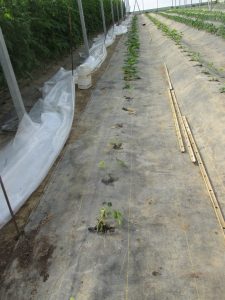
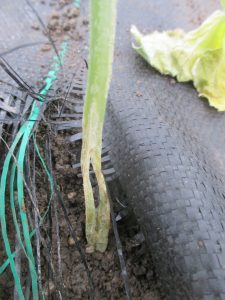
Unheated high tunnels
Another significant benefit we observed on grafted cucumbers is a higher transplant survival rate under lethal soil temperatures in the spring in unheated high tunnels. Newly planted cucumber seedlings may wilt and die when average soil temperatures were around 55°F for two or more nights depending on the variety, the status of the seedlings, and temperatures during the day. A significant amount of plants will be lost if average soil temperatures are in the lower 50°F range. An advantage of using grafted cucumbers is that they are likely to survive in these lethal soil temperatures. Jim Baughman at Freedom Valley Farm commented that he is really amazed by the hardiness of the grafted plants. He lost more than 70% of non-grafted cucumber plants but none of the grafted ones after transplanted on March 31, 2018, in an unheated high tunnel. He reported a low air temperature inside the high tunnel at 21°F one morning in early April 2018. Data loggers recorded minimal air (under row covers) and soil (4’’-depth) temperatures were 33°F and 48°F in his high tunnel after transplanting.
Undoubtedly, Jim is very experienced at managing temperatures in an unheated high tunnel in the spring. But still, there is an extremely high risk of losing all the plants when temperatures dropped to that level. Actually, this is exactly what happened at the Perkins’ good earth farm. The temperature around the plants dropped to 28°F, that temperature killed all the cucumber plants regardless of whether grafted or not.
Using grafted plants provides a higher chance for seedling survival if frost occurs after transplanting. This is surely an advantage of using grafted plants. However, we realize that in reality, growers may not take the risk of planting cucumbers in an unheated high tunnel if frost is expected shortly after transplanting. Most growers may wait until the frost has passed. So that they may not benefit from a higher transplant survival rate of grafted plants under lethal soil temperatures.
The next question is whether grafted plants bring higher yield if they were planted after the spring frost passed. Not surprisingly, we found this is very weather-depended. In 2018, we experienced an unusually cold April. Most growers delayed planting cucumbers in unheated high tunnels till about end April. May is quite warm in 2018. Average soil temperatures were in the upper 60°F in May and stayed above 70°F in June and July in our trials across Indiana. We saw little difference in plant growth and yield between grafted and non-grafted cucumbers. While in 2017, cucumbers were planted on March 31 and successfully established in two growers’ unheated high tunnels. Growers reported more vigorous and healthier looking grafted plants compared to non-grafted. Yield improvement ranged from 6% to 159% depending on varieties. In the situations that yield on grafted plants was almost doubled compared to non-grafted cucumbers, this was due to plant loss caused by bacterial wilt. However, we did not see differences in susceptibility to bacterial wilt between grafted and non-grafted cucumbers on other farms.
Table 6. Yield per plant of non-grafted and grafted Iznik and Socrates at the Perkins Good Earth Farm.
|
Variety |
Treatment |
June |
July |
Total |
|
Iznik |
Non-grafted |
2.19 |
6.78 |
8.97 |
|
Iznik |
Grafted with Marval rootstock |
2.43 |
8.11 |
10.54 |
|
Socrates |
Non-grafted |
2.52 |
9.49 |
12.02 |
|
Socrates |
Grafted with Marval rootstock |
2.91 |
9.62 |
12.53 |
Table 7. Yield per plant of grafted and non-grafted Corinto at S&E Produce & Flower farm.
| Treatment |
May to June |
|
Non-grafted Corinto |
7.78 |
|
Corinto grafted onto Marval |
8.14 |
More questions need to be answered
A big surprise to us is that we noticed grafted plants were less healthy, and yield was reduced on grafted plants at Bud's Farmers Market. The same trend was observed in both 2017 and 2018 at the same high tunnel. A unique situation for this greenhouse was very high, above 8 soil pH and relatively higher soil salinity. We suspect the grafted plants may be more susceptible to high soil pH and salinity. Further research in this area is needed.
The observation that unexpected pest damaged stems of non-grafted cucumber plants but not the grafted plants in one greenhouse was a surprise. Unfortunately, we were not be able to catch the pest and confirm it, but according to our entomologist, the damage looked like it was caused by seedcorn maggot (Figure 4), which is a common pest that occurs in early spring when the soil is cool. We would like to confirm this observation and understand why this happens.
Economic analyses
We estimated the cost of grafted cucumber plants is about $1.36 per plant, which is 2.3 times more expensive than the normal cucumber plants.
Table 8. The estimated cost of grafted vs. normal cucumber plants
| Item | Grafted | Non-grafted | |||
| Materialsx | Labory | Materials | Labor | ||
| ($/1000 plants) | ($/1000 plants) | ||||
| Seeds | Scion (Socrates) | $416.25 | - | $333.00 | - |
| Rootstock | $168.75 | - | $0.00 | - | |
| Seedling production | Potting soil | $55.00 | - | $22.00 | - |
| Flats | $52.50 | - | $21.00 | - | |
| Seed sowing and care | - | $105.67 | - | $42.27 | |
| Grafted transplant production | Grafting labor | - | $131.87 | - | $0.00 |
| Grafting clips | $119.40 | - | $0.00 | - | |
| Grafting supplies (razor blade, sanitizer, paper towls etc.) |
$16.25 | $0.00 | |||
| Post-graft healing | Grafting chamber | $68.70 | $0.00 | ||
| Humidifier | $50.00 | $0.00 | |||
| Post-graft care | $38.07 | $0.00 | |||
| Greenhouse heating | $140.00 | $0.00 | |||
| Subtotal | $1,086.85 | $275.61 | $376.00 | $42.27 | |
| Total Costs | $1,362.46 | $418.27 | |||
| Cost/plant | $1.36 | $0.42 | |||
Then we conducted partial return analyses based on yield results from research trials conducted from 2016-2018. The analyses indicated that assuming all the production costs, expect transplant cost, are the same for growing grafted and non-grafted cucumbers. Growers can make more money in growing grafted plants (Figure 5). This analyses used a flat cucumber price $1.5/lb and did not consider potential premium price in the early season. We are conducting more in-depth studies to evaluate the economic feasibility of using grafting technology in high tunnel cucumber study.
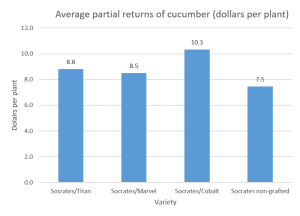
Educational & Outreach Activities
Participation Summary:
Extension bulletin and video demonstrating cucumber grafting technology
A factsheet How to Splice Graft Cucumber Plants was published through Purdue Extension. The publication can be downloaded free at https://mdc.itap.purdue.edu/item.asp?itemID=23252
A video How to Splice Graft Cucumber Plants was published through Purdue Extension. The video is available at https://www.youtube.com/watch?v=z-tXoobiMnY&t=10s
Published press articles, newsletters
Cucumber grafting on-farm trials conducted at the White Violet Center was showcased at the Eco-Justice Natual day event. Indiana public media participated in this event, and reported the cucumber grafting project. The radio show and the report can be accessed at https://indianapublicmedia.org/eartheats/grafting-cucumbers-pickling-radishes/
Vegetable Crops Hotline Newsletter. Issue 653. Learn How to Graft Cucumber and Tomato Plants https://vegcropshotline.org/article/learn-how-to-graft-cucumber-and-tomato-plants/
Vegetable Crops Hotline Newsletter. Issue 652. Are You Interested in Participating in a Grafted Cucumber Study? https://vegcropshotline.org/article/are-you-interested-in-participating-the-grafted-cucumber-study/
Vegetable Crops Hotline Newsletter. Issue 652. Growing Grafted Cucumbers for Early Season Production in Protected Cultural Systems - Lessons Learned from on-farm Trials. https://vegcropshotline.org/article/growing-grafted-cucumbers-for-early-season-production-in-protected-cultural-systems-lessons-learned-from-on-farm-trials/
Vegetable Crops Hotline Newsletter. Issue 640. Check Soil Temperatures before Planting Cucumbers in a High Tunnel. https://vegcropshotline.org/article/check-soil-temperatures-before-planting-cucumbers-in-a-high-tunnel/
Vegetable Crops Hotline Newsletter. Issue 637. Are You Interested in Growing Greenhouse Type Cucumbers in High Tunnels, and Targeting for Early Season Production? https://vegcropshotline.org/article/are-you-interested-in-growing-greenhouse-type-cucumbers-in-high-tunnels-and-targeting-for-early-season-production/
Tours
2018 Southwest Purdue Agricultural Center High Tunnel Tour (attendance 25)
2017 Southwest Purdue Agricultural Center High Tunnel Tour (attendance 35)
2017 Southwest Purdue Agricultural Center Field Day (attendance 70)
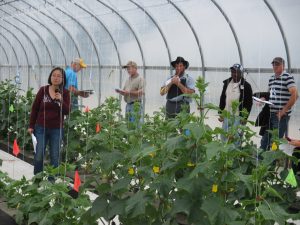
Takes and Presentations
2019 Indiana Small Farm conference. Cucumber grafting. Danville, IN. Mar. 2019. (Attendance: 25)
2019 Indiana Small Farm conference. Cucumber grafting demonstration. Danville, IN. Mar. 2019. (Attendance: 50)
Indiana Hort Congress. Seedless cucumber: another high-value crop for high tunnels and what grafting could do. Indianapolis, IN, Feb. 2019. (Attendance: 34)
Illiana Vegetable Growers Symposium. Cucumber production in high tunnels. Schereville, IN. Jan. 2019. (Attendance: 33)
Parke County Vegetable Growers Meeting. Cucumber production in high tunnels. Marshall, IN. Dec. 2018. (Attendance: 33)
Other Activities
We invited collaborate farmers visit Southwest Purdue Ag Center facility during the period when we were producing grafted transplants. Mr. Bud and Jim, and Ms. Candace visited us. They learned the cucumber grafting technique. They all indicated that they are very interested in using this technique at their farms.
In addition to farmers, we trained university students and international visitors about cucumber grafting at the Southwest Purdue Ag Center in Nov. 2017. The audience included 14 undergraduate student from Vincennes University and 3 visitors from Herat University, Afghanistan. They showed a strong interest in learning this technique (Fig. 4).

On-going Activities:
We are working with individual farmer to set up grafting facility at their own farm. At least three collaborate farmers expressed interest. We will develop specific protocols depending on the unique situation of each farm. The goal of the effort is to help farmers successfully grow their own grafted plants.
Learning Outcomes
Importance of soil temperatures in cucumber production
The benefit of using grafting technology in cucumber production
Cucumber grafting technique
Project Outcomes
Immediate outcomes of the project are improved yield and extended harvest duration of cucumbers grown in high tunnel systems in the North Central Region. Introduction of the new technology made high tunnel cucumber production more profitable and encouraged farmers to grow cucumbers as a rotational crop to tomatoes. In the long term, the changes in farmers’ activities increase the sustainability of high tunnel production system and increase farmer income.